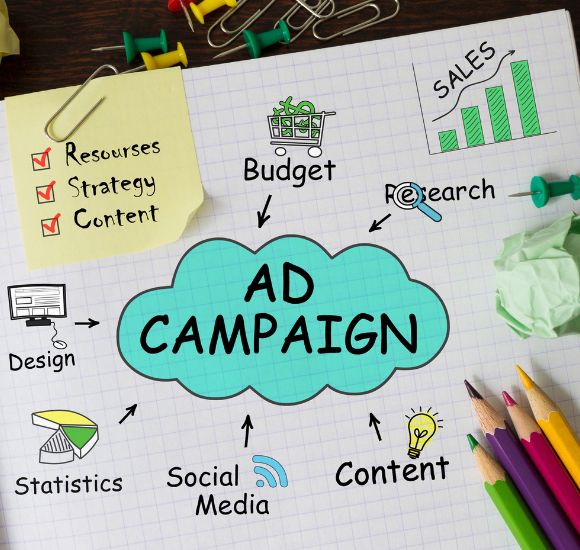Mastering the art of copywriting
In the ever-evolving world of digital marketing, one skill remains consistently in demand: Copywriting. Let’s discuss the art of writing persuasive content in a detailed manner which will serves as a guide for both novice and experienced copywriters alike. Let’s break down the key elements and explore how you can apply these principles to enhance your copywriting skills.
Before You Begin: The Preparation Phase
Successful copywriting doesn’t start with the first word you type; it begins much earlier. The importance of preparation is critical for for copywriting, listing five crucial steps:
- Do Research: Understanding your subject matter, audience, and competitors is critical. This helps you craft messages that resonate and stand out.
- Discover Your Prospect: Knowing who your audience enables you to tailor your message to their needs, desires, and pain points.
- Get Your Client Involved: Collaborate with your client to ensure that the messaging aligns with their goals and values.
- Develop a USP (Unique Selling Proposition): Identify what sets your product or service apart from the competition.
- Prepare to Write: Organize your thoughts and outline the structure of your copy before you start writing.
The Copywriting Process: From Blank Page to Polished Content
The process of creating compelling copy is methodical and involves several stages:
- Blank: Every great piece of copy starts with a blank page. Don’t let it intimidate you; use it as a canvas to bring your ideas to life.
- Outline: Structure is key to effective communication. An outline helps you organize your thoughts and ensures your message flows logically.
- Collect: Gather all necessary information, data, and resources to support your message. This includes facts, testimonials, and any relevant media.
- Write: With a clear structure and all your resources at hand, begin writing. Focus on clarity, conciseness, and persuasive language.
- Edit: Refining your copy is just as important as writing it. Review your content for clarity, grammar, and style, and make sure it aligns with your objectives.
Crafting Headlines and Subheadlines
Key elements to include in your headlines and subheadlines:
- Focus on benefits, not features: Readers are more interested in how your product or service will improve their lives rather than the technical details.
- Answer “WIIFM?” (What’s In It For Me?): Always keep the reader’s perspective in mind.
- Use repetition and rhythm: These can make your message more memorable and persuasive.
Testing and Reviewing: The Final Steps
Testing and reviewing your copy are vital steps that ensure your message is as effective as possible.
- Testing: Whether through A/B testing or another method, test different versions of your copy to see which performs best.
- Reviewing: After testing, review the results and make necessary adjustments to improve clarity, engagement, and conversion rates.
The Art of Persuasion: Advanced Techniques
- Tell stories: Storytelling is a powerful way to connect with your audience on an emotional level.
- Use metaphors and analogies: These can make complex ideas more relatable and understandable.
- Write in an active voice: Active voice is more direct and engaging than passive voice.
- Tap into emotions: Emotional appeal can be a powerful motivator, driving readers to take action.
One of the most effective ways to differentiate your brand is by developing a compelling Unique Selling Proposition (USP).
A Unique Selling Proposition is the distinct and appealing idea that sets you and your business favorably apart from every other generic competitor. It answers two fundamental questions:
- What’s in it for me? – This addresses the benefits your product or service offers to the customer.
- What makes you unique? – This highlights what differentiates you from other businesses in your market.
To craft a strong USP, your answer to these questions should be:
- Simple: Easily understood by your target audience.
- Short: Concise enough to be memorable.
- Benefit-focused: Clearly communicates the value to the customer.
- Emotional: Appeals to the emotions of your audience.
- Memorable: Sticks in the mind of your audience, making them more likely to remember and choose your brand.
Avoiding Clichés: The Wrong Way
One of the key points is the importance of avoiding clichés. Overused phrases like “Lowest prices in town,” “Great customer service,” or “We’ve been in business for more than 30 years” do not set you apart from the competition. These tired, worn-out phrases are far from unique and often fall flat because they are too generic and fail to convey real value.
Brainstorming Your USP: Generating Unique Ideas
Creating a compelling USP requires thoughtful consideration of what truly makes your product or service unique. Brainstorming ideas by asking questions about your offering:
- Is your product or service easier, faster, or more widely available?
- Is it simpler, cheaper, or does it offer a better guarantee?
- Is it prettier, more efficient, or smaller?
- Does it offer better value, a better design, or is it of higher quality?
- Is it cutting-edge or more time-tested?
By answering these questions, you can identify the unique aspects of your offering that set you apart from competitors.
USP Hall of Fame: Learning from the Best
To inspire your own USP, the infographic includes a “Hall of Fame” showcasing some of the best USPs ever created. Examples include:
- Idea : An Idea can Change your life
- Sprite: Bujhaye pyas, baaki all, bakwas! ( Quenches only your thirst, remaining everything is nonsense )
- Amul: The Taste Of India
- Gillette: The Best a man can get
- De Beers: Diamonds are forever
- Visa: Everywhere you want to be
- BMW: The ultimate driving machine
- Adidas: Impossible is nothing
These examples are powerful because they are concise, benefit-focused, and memorable. They convey a clear value proposition that resonates with customers and differentiates the brand from its competitors.
Delivering on Your USP: Proving It
It’s not enough to just create a USP; you must also deliver on it. The importance of proving your USP with statistics, testimonials, and charts is critical. This evidence supports your claims and builds trust with your audience. If you promise something in your USP, make sure you can back it up with real results.
Why Headlines Matter
The Power of Words
Certain words have the power to grab attention and evoke curiosity. Power Words—words like FREE, New, Easy, How To, Discover, Now, and Proven. Including these in your headline can significantly boost its effectiveness, as these words tap into universal desires and promises that resonate with readers.
Keys to a Great Headline
To craft a headline that truly works, here are some actionable tips:
- Focus on a Benefit: Make sure your headline highlights the main benefit your audience will receive. If the key benefit is saving time, emphasize that.
- Be Specific: Vague headlines don’t work. Instead of saying “over 1000,” say “1262” to be precise. Specificity builds credibility.
- Include Your Guarantee: Offering a guarantee can increase trust. For example, “Try It For 30 Days, And If You Don’t Like It – I’ll Buy It Back!”
- Make It Timely: Tie your headline to a current event or trend to make it more relevant.
- Include Your USP: Highlight what makes your product or service unique. Your Unique Selling Proposition (USP) should be clear in the headline.
- Answer Why, How, and What If?: Address common objections that might be on your prospect’s mind.
- Include a Number: Numbers in headlines, like “7 Ways To…” or “5 Steps To…”, are highly effective because they promise clear, actionable steps.
- Add a Time Limit: Create urgency by including a time frame, like “In Just 10 Minutes a Day…” or “Only 7 Days…”
- Create an Image of the End-Result: Help the reader visualize the benefit they’ll receive.
- Identify with Your Target Market: Tailor your headline to speak directly to your audience, e.g., “For Accountants:…”
- Be 100% Truthful: Never mislead with your headline. Honesty builds trust and credibility.
The Headline Laboratory
- Use Amazon: Go to Amazon and search for books related to your topic. Look at the top-selling books’ titles and extract common words or phrases that work. Incorporate these into your headlines.
- Keep a Swipe File: Maintain a collection of the best headlines you come across. Analyze what makes them work and adapt those principles to your own headlines.
- Ask Questions: Engage the reader’s mind with questions that lead to a “YES” response, such as “Isn’t It Time You…?” or “Aren’t You Tired Of…?”
- Do a Google Search: Use Google to find headline formulas, headline tips, and headline ideas. There are countless resources available online to inspire and guide you.
Why Subheadlines Matter
Subheadlines are more than just smaller versions of your main headline. They serve a unique purpose: to maintain the reader’s interest and guide them deeper into your content. Each subheadline should evoke curiosity, encouraging the reader to continue reading. They act as signposts, directing attention and breaking up large chunks of text into digestible sections.
Key Principles for Effective Subheadlines
- Use Curiosity to Engage Readers
- One of the primary functions of a subheadline is to pique the reader’s curiosity. By hinting at what’s to come, you motivate the reader to keep going. This technique is especially useful for maintaining interest in longer pieces of content.
- Recycle Discarded Headline Ideas
- A great source of subheadline ideas can be your discarded main headline ideas. These phrases, though not strong enough to be the main headline, can still provide value when used as subheadlines, adding depth and variety to your copy.
- Follow the Same Styling Guidelines as Headlines
- While subheadlines should be slightly smaller than your main headline, they should still stand out. Use a different color from your main headlines to create a visual hierarchy, making it easy for readers to navigate your content.
- Tell the Complete Story of Your Copy
- When read together, your subheadlines should give a clear overview of your content. They should tell the complete story of your copy, summarizing the key points and allowing readers who skim to understand the main message.
- Write in an Active Voice
- Writing subheadlines in an active voice makes them more direct and engaging. For example, “I Was Amazed With What I Read!” is more compelling than “What I Read Amazed Me.” Active voice not only grabs attention but also gives your copy a sense of urgency and energy.
- Relate Subheadlines to the Main Benefit
- Your subheadlines should always connect back to the main benefit of your product or service. This keeps the reader focused on the value you’re offering and reinforces the core message of your copy.
Subheadlines and the Reader’s Eye
Readers often scan a page before deciding whether to engage fully with the content. Subheadlines help capture and direct their attention. Subheadlines make your copy more easily digestible by breaking it down into manageable sections. This not only improves readability but also increases the chances that your message will resonate with the audience.
Best Practices for Using Subheadlines
- Use Subheadlines Frequently: The more subheadlines you use, the more opportunities you have to re-engage the reader. This is particularly important in long-form content where maintaining attention can be challenging.
- Keep Them Relevant: Ensure that each subheadline adds value and stays relevant to the content that follows. Irrelevant or misleading subheadlines can confuse readers and detract from the overall message.
- Experiment with Different Styles: Don’t be afraid to experiment with different styles and placements of subheadlines to see what works best for your audience. This could include varying the length, tone, or even the use of questions or exclamations.
Elevate Your Copywriting Skills
Mastering the art of copywriting is a journey that involves preparation, practice, and a deep understanding of your audience. By focusing on crafting compelling headlines, refining your unique selling proposition, and employing persuasive techniques, you can create copy that not only captures attention but also drives action. Whether you’re just starting or looking to refine your skills, these strategies will help you elevate your writing and make a lasting impact. Remember, great copy doesn’t just inform—it inspires, persuades, and converts. Start applying these principles today to see the difference in your copywriting effectiveness.







